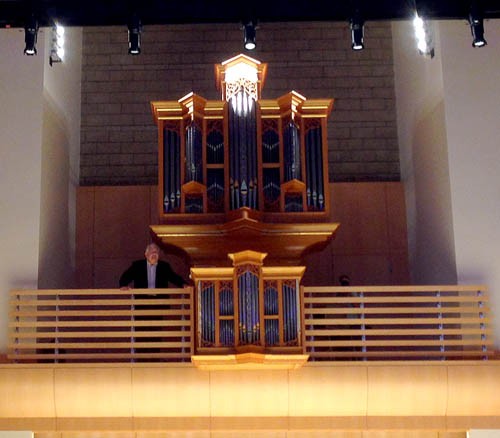The most fascinating aspect of the Green Music Center’s Schroeder Hall isn’t the building itself—it’s not even the incredible Brombaugh Opus 9 organ housed above the stage—it’s the way the two came together.
The 250-seat hall opening this weekend at Sonoma State University is designed for students. It serves doubly as a lecture space and a recital hall, with permanent wooden chairs and desktops that fold onto one’s lap from the side of the seat. But as much attention was paid to the acoustics of the space as the main hall, which has hosted internationally known superstars like Tony Bennett, Yo-Yo Ma and Allison Krauss.
During construction of Schroeder Hall, the university had a chance to purchase the Brombaugh organ, which Oberlin College music professor and organist James David Christie calls an “absolute masterpiece.” Since the purchase was made during the design phase, the hall was actually acoustically tailored to fit this one instrument. When Christie played a piece he wrote for his sister’s wedding at a media preview earlier this week, the marriage of the instrument and it’s new home proved to be a perfect union, indeed.
Christie says he chose the piece specifically because it showed off the full range of the instrument, which rang true. In Schroeder Hall, the low pedal bass of the organ was powerful but not overly so, and the midrange was present but not piercing. The highs were mellow, and the sound was crisp and clear through the nearly five-second reverberation of the stone, oval building. All frequencies are even and the timbre is unique and pleasing. “When playing this organ one immediately feels at one with the room,” Christie said after his performance.
[jump]
The Opus 9 tracker organ was designed and built by legendary American organ builder John Brombaugh as the ninth in a set of 66 instruments. The 1,248-pipe beauty was originally built in 1972 for a Baptist church in Toledo, Ohio. And holy Toledo, does it sound better in Schroeder Hall. “It sounds 100 percent better in this hall than the church it was in,” says Christie. “It was a great organ transplant.” It’s designed to sound closer to a 16th Century Renaissance organ, where as most made today aim more for a Baroque-era timbre. The result is a fatter sound with a less percussive effect.
What’s unique about this instrument is the attention to detail. It sits above the stage in the choir loft, with the audience facing it, and the visible pipes are hand-hammered. This is not common on organs because A) it’s difficult to do without destroying the sound; and B) it’s quite time consuming and only done for aesthetics. The result is absolute beauty for the eyes and ears. The completed project is the only one I’ve seen that looks like it jumped off the page of an architect’s rendering.
The organ was bought in 2005 through a gift from BJ and Bebe Cassin, Sonoma Bach Choir director Bob Worth and Margaret McCarthy, as well as Green Music Center namesakes Don and Maureen Green. It was housed in a Rochestor, NY church until its installation at SSU this year. While in New York, the organ was reportedly a favorite of music professors at the nearby Eastman School of Music.
The hall, named after the Beethoven-loving Peanuts character at the suggestion of major donor and Peanuts creator Charles Schulz’s wife, Jeanne, hosts a series of free opening-weekend concerts this weekend. See http://gmc.sonoma.edu for details.














